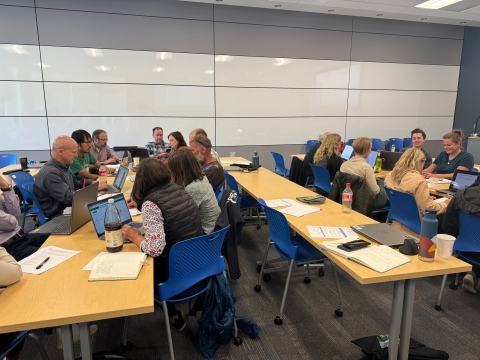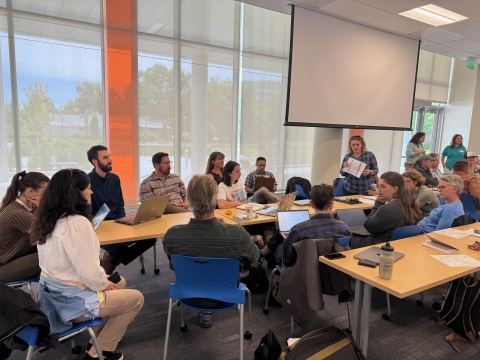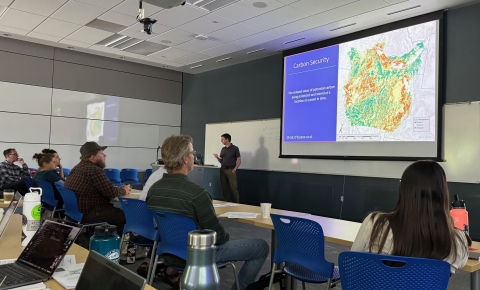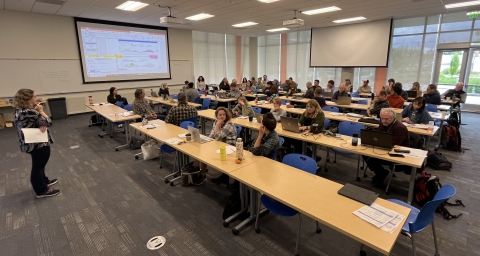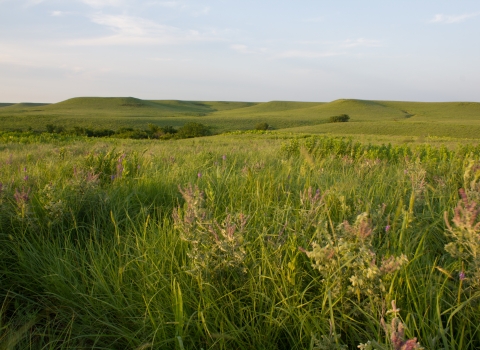WHAT: Building upon the success of the 2022-2023 Climate Change and Climate Adaptation Training Series for Grasslands Practitioners, the US Fish and Wildlife Service (Service) Regions 1, 6, and 8 partnered in 2023-2024 with multiple US Geological Survey (USGS) Climate Adaptation Science Centers (CASCs) to develop and deliver another climate adaptation training series for sagebrush sagebrush
The western United States’ sagebrush country encompasses over 175 million acres of public and private lands. The sagebrush landscape provides many benefits to our rural economies and communities, and it serves as crucial habitat for a diversity of wildlife, including the iconic greater sage-grouse and over 350 other species.
Learn more about sagebrush practitioners. This series began with virtual classroom sessions and culminated with an in-person, two-day workshop in Boise, Idaho.
WHY: Ecosystem-focused trainings were previously identified by the CASCs as a potential method for increasing knowledge and building capacity around climate change climate change
Climate change includes both global warming driven by human-induced emissions of greenhouse gases and the resulting large-scale shifts in weather patterns. Though there have been previous periods of climatic change, since the mid-20th century humans have had an unprecedented impact on Earth's climate system and caused change on a global scale.
Learn more about climate change . Likewise, delivering these types of trainings meets one of the Service’s national priorities to “develop a climate literate workforce that has the knowledge, skills and abilities to successfully address climate adaptation and mitigation needs throughout all programs and regions of the Service.”
WHO: The focal audience for the 2024 Climate Change and Climate Adaptation Training Series was the Service’s Sagebrush Ecosystems Team (SET). Members of this team participated in the training series and guided its development and implementation along with a team of experts from the Service’s Science Applications, Ecological Services and National Wildlife Refuge Programs, four regional CASCs, and multiple university partners. Since much of the training was interactive and involved peer-to-peer knowledge sharing, other sagebrush practitioners were invited to join the training including members of the Service outside the SET, the Bureau of Land Management (BLM), the National Park Service, other Federal agencies, state agencies, Tribes, and additional sagebrush land managers.
This training series kicked off with in an introductory, self-paced online course that was administered in February 2024 to sagebrush practitioners. This initial piece of the training series provided participants with an opportunity to explore at their own pace the science behind climate change, an introduction to climate projections, and potential climate change impacts. A total of 99 individuals registered to participate in the self-paced course and 77 actively engaged with the course material.
HOW: Throughout the spring of 2024, four 90-min virtual classrooms were designed and delivered based on specific topics of interest to the SET and other sagebrush practitioners. Advance registration numbers ranged from about 50 to over 100, and most had over 50 participants who attended the sessions live. Topics covered included a Sagebrush and Climate Change Overview, Sagebrush-associated Wildlife Vulnerabilities to Climate Change, Introduction to Climate Tools, and Interpreting Climate Models and Projections. All virtual classrooms were recorded and the presentations are available on the South Central CASCs website (https://southcentralclimate.org/resources/webinars-workshops/training-for-sagebrush-conservation-practitioners/).
RESULTS: The final and most impactful part of the training series was a 2-day, in-person workshop at the end of May 2024. Approximately fifty people attended this workshop, primarily from the Service, USGS, and BLM. Using a broad Learn-Do-Reflect approach, the workshop included information delivery, hands-on tool training, peer-to-peer knowledge exchange and networking, and a scenario-based exercise. Based on feedback from the 2023 grasslands in-person workshop, we interwove presentations with interactive role-playing exercises during both days of the sagebrush workshop. Day 1 included presentations and activity elements around the Sagebrush Conservation Design, climate impacts on sagebrush systems, understanding on the ground management needs, and accessing climate data through the Climate Toolbox. On Day 2, we introduced the participants to landscape treatments and seasonal forecasting, scenario planning, the resist-accept-direct (RAD) framework, and compound events. The role-playing activity was designed to help resource managers and others learn how to pull the information from presentations and web-based resources into a climate-informed decision-making process.
We solicited feedback on both the workshop and the self-paced virtual introduction, and in general the feedback was very positive, suggesting meaningful improvements in both climate knowledge and practical skills to apply climate knowledge in planning and management. Of the eighteen evaluations received on the workshop, many rated their prior knowledge of climate adaptation planning as “poor” or “fair”, but all said their level of knowledge had improved to “satisfactory”, “very good” or “excellent” by the end of the workshop. One participant shared, “Excellent job! I feel like this was one of the most informative workshops/conferences I have been to.” Another shared, “This workshop will help me write the climate change portion of the EAs in the coming future.”
Feedback from both the Grassland and Climate Training Series and the Sagebrush and Climate Training Series confirmed that climate literacy varies widely among Service staff and partners. Focused trainings can effectively address this information gap across multiple Service programs. Bringing staff from multiple Programs into a common training environment helped participants understand climate impacts and potential adaptive actions across the range of Service responsibilities, ultimately helping staff better contribute to the Service’s mission. Multiple collaborative planning efforts between the Service and the CASCs emerged as result of the grassland workshop, and likewise we expect that bringing multiple Programs and partners together for the sagebrush workshop will result in continued knowledge sharing.
All materials associated with this entire training series are located on the South Central Climate Adaptation Science Center website. For further inquiries about the training, contact Elise Elliott-Smith (eelliott-smith@usgs.gov) or Emma Kuster (emmakuster@ou.edu).

